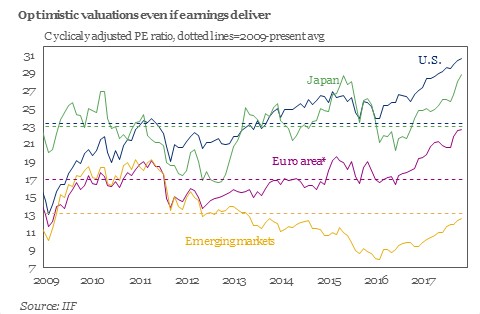Relative Valuations
We’ve seen a coordinated stock market rally in about every index globally. The chart below compares the recent Shiller PEs of the American, Japanese, European, and Emerging stock markets. The dotted lines are the average since the start of this bull market in 2009. As you can see, America, Japan, and Europe are all above their recent averages. Considering the fact that the past few years of weakness has moved the 8 year average down considerably, the fact that emerging markets are below their average valuation, and that their economies are looking great, it would seem like a no-brainer to get involved in them. This latest boost in the expansion has sustained itself without much commodity price improvement. Eventually, that will change if growth keeps going as the growth will be demanding more of finite resources. In general, low prices discourage new initiatives which produce more of the commodity. However, that’s obviously not the case in America with oil and gas drilling. Instead, firms are working to lower their costs, so they can produce more oil and gas profitably. The point I’m getting at is these emerging markets who produce commodities will get an additional boost in the next couple of years from higher commodity prices, making their investing prospects stronger.

Is America The Next Saudi Arabia?
I mentioned the expansive production of American oil and gas fracking. The chart below gives context to how large the U.S. shale production boom in the past few years has been. As you can see, the U.S. production boom has more than matched the production boom Saudi Arabia experienced from 1966 to 1981. The politicians wanted America to get off foreign oil dependence, but the private companies did the grunt work. The production of American oil is much more impressive than Saudi production because the oil is locked in rocks. When oil prices fell starting in late 2014, many prognosticators predicted the fracking boom would be over. However, the break-even prices were lowered. The low-interest rates helps the fringe energy firms at the margin, but it would be foolish to say the whole innovation boom was caused by low rates.













Leave A Comment